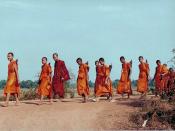As with most belief systems, tradition and cultural heritage in Buddhism influence an adherentÃÂs way of life, by providing guidelines for ÃÂcorrect livingÃÂ. The future of Buddhism is determined by the adherence to Buddhist tradition and the continuation of its particular cultural heritage. For the purpose of this essay, tradition is defined as a long established or inherited way of thinking or acting, and cultural heritage is defined as is an expression of the ways of living developed by a community and passed on from generation to generation.
In this essay I will focus on the role of Buddhism in Thailand, and how the absence of ÃÂpureÃÂ Buddhism has led to a compromise of both Buddhist and traditional Thai ideology. The place of gender roles in Buddhism and how Thai roles continue or challenge tradition will be evaluated, as well as how changing Thai ideology in relation to modernisation will affect many aspects of Buddhism and its cultural heritage.
Before analysing a particular society, one must understand the principles of Buddhism itself. Buddhism has its origins in India, sending out many missionaries into parts of Asia during the second and first centuries BCE. Buddhism was firmly established in the southern and central provinces of Thailand by the sixth century AD. Thai Buddhists have adopted the school of Theravada (often referred to as the Southern tradition), based on the Pali canon. It is thought that this school was developed in Thailand during the thirteenth century AD, sponsored by King Ramkham-haeng.
Theravada Buddhism translates to ÃÂteaching of the eldersÃÂ, and aim to practice the original form of Buddhism handed down by Buddha. This form of Buddhism was established during the third century BCE in order to ÃÂpurifyÃÂ the religion, and developed the Pali canon, which contains the Tripitaka (Hooker, 1996). Advocates of...


